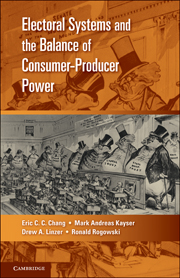Book contents
- Frontmatter
- Contents
- Acknowledgments
- 1 Introduction
- 2 Electoral Systems and Consumer Power: Theoretical Considerations
- 3 Electoral Systems and Real Prices: Panel Evidence for the OECD Countries, 1970–2000
- 4 Electoral Systems and Real Prices around the World
- 5 A Closer Look: Case Studies and Mechanisms
- 6 Socioeconomic Origins of Electoral Systems
- 7 Conclusion
- Bibliography
- Index
4 - Electoral Systems and Real Prices around the World
Published online by Cambridge University Press: 05 June 2012
- Frontmatter
- Contents
- Acknowledgments
- 1 Introduction
- 2 Electoral Systems and Consumer Power: Theoretical Considerations
- 3 Electoral Systems and Real Prices: Panel Evidence for the OECD Countries, 1970–2000
- 4 Electoral Systems and Real Prices around the World
- 5 A Closer Look: Case Studies and Mechanisms
- 6 Socioeconomic Origins of Electoral Systems
- 7 Conclusion
- Bibliography
- Index
Summary
We have proposed that a democracy's electoral rules are linked to the regulatory output of that country's elected legislators, and that this effect manifests itself in a country's real-price levels. In particular, we contend that the greater seat-vote elasticities of majoritarian electoral systems will tilt policy in favor of consumers, while proportional systems should strengthen producers; and that the pro-consumer bias of majoritarian systems should lead to systematically lower prices.
Empirical testing of our hypothesis in Chapter 3 supported the expected relationship between majoritarian electoral institutions and lower real prices among the wealthy, developed democracies of the Organization for Economic Cooperation and Development (OECD). Among the twenty-three OECD democracies, a country that shifted from a proportional to a majoritarian electoral system was estimated typically to enjoy a short-run yearly reduction in real prices of about 1.2 index points (where U.S. prices = 100), corresponding to a long-run reduction in real prices of at least 10 percent. This is about half of a standard deviation of average prices across OECD countries – over time, a significant effect.
- Type
- Chapter
- Information
- Electoral Systems and the Balance of Consumer-Producer Power , pp. 99 - 134Publisher: Cambridge University PressPrint publication year: 2010

